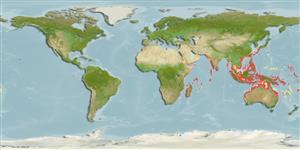Environment: milieu / climate zone / depth range / distribution range
Ökologie
seewasser; brackwasser riff-verbunden; tiefenbereich 0 - 40 m (Ref. 90102). Tropical
Indo-West Pacific: India to China, Philippines, Papua New Guinea and Australia. Reported from Vanuatu (Ref. 13300).
Size / Gewicht / Alter
Maturity: Lm ? range ? - ? cm
Max length : 60.0 cm TL Männchen/unbestimmt; (Ref. 4690)
Rückenflossenstacheln (insgesamt): 13 - 14; Rückenflossenweichstrahlen (insgesamt): 6; Afterflossenstacheln 3; Afterflossenweichstrahlen: 5. A drab species, usually brownish grey to reddish brown with a pattern of fine lines across the caudal fin. Eyes well elevated compared to the reef stonefish S. verrucosa (Ref. 48635).
Inhabits coastal reefs and estuaries (Ref. 9710). Makes a shallow depression by scooping up sand or mud with its pectoral fins until it is piled up around the sides of its body. Lies motionless on sandy bottom areas. Comes out at night and often moves on top of reefs (Ref. 48635). In Guinness Book of Records as most venomous fish (Ref. 6472). Solitary in coral rubble and rocks, extremely difficult to detect (Ref 90102).
Life cycle and mating behavior
Geschlechtsreife | Fortpflanzung | Ablaichen | Eier | Fecundity | Larven
Randall, J.E., G.R. Allen and R.C. Steene, 1990. Fishes of the Great Barrier Reef and Coral Sea. University of Hawaii Press, Honolulu, Hawaii. 506 p. (Ref. 2334)
IUCN Rote Liste Status (Ref. 130435)
Nutzung durch Menschen
Aquarium: Öffentliche Aquarien
Mehr Information
NamenSynonymeMetabolismusRäuberÖkotoxikologieFortpflanzungGeschlechtsreifeAblaichenSpawning aggregationFecundityEierEientwicklung
ReferenzenAquakulturAquakultur ProfilZuchtlinienGenetikElectrophoresesVererbbarkeitKrankheitenVerarbeitungNutrientsMass conversion
PartnerBilderStamps, Coins Misc.LauteCiguateraGeschwindigkeitSchwimmstilKiemenoberflächeOtolithsGehirngrößeSehfähigkeit
Tools
Zusatzinformationen
Download XML
Internet Quellen
Estimates based on models
Preferred temperature (Ref.
123201): 24.4 - 29, mean 27.9 °C (based on 874 cells).
Phylogenetic diversity index (Ref.
82804): PD
50 = 0.5312 [Uniqueness, from 0.5 = low to 2.0 = high].
Bayesian length-weight: a=0.01622 (0.00609 - 0.04318), b=3.05 (2.82 - 3.28), in cm total length, based on LWR estimates for this (Sub)family-body shape (Ref.
93245).
Trophic level (Ref.
69278): 4.4 ±0.8 se; based on size and trophs of closest relatives
Widerstandsfähigkeit (Ref.
120179): sehr niedrig, Verdopplung der Population dauert mehr als 14 Jahre. (Preliminary K or Fecundity.).
Fishing Vulnerability (Ref.
59153): Moderate vulnerability (44 of 100).
Nutrients (Ref.
124155): Calcium = 35.7 [17.6, 70.5] mg/100g; Iron = 0.558 [0.288, 1.280] mg/100g; Protein = 18.2 [16.6, 19.7] %; Omega3 = 0.19 [0.08, 0.49] g/100g; Selenium = 32.4 [16.6, 74.8] μg/100g; VitaminA = 125 [40, 395] μg/100g; Zinc = 1.21 [0.84, 1.76] mg/100g (wet weight);
